Python 演算法 Day 9 - Exploratory Data Analysis
Chap.II Machine Learning 机器学习
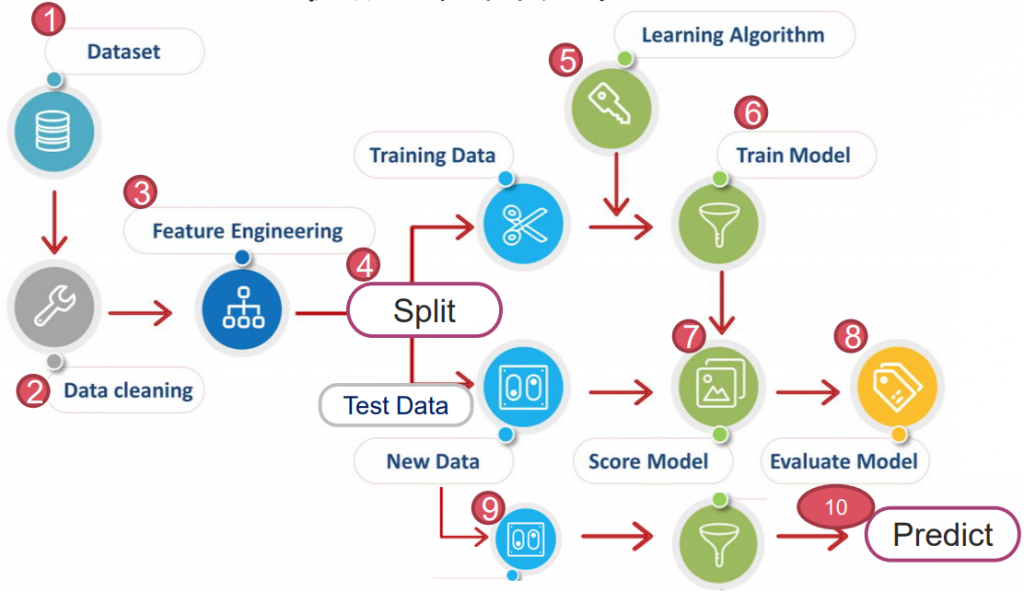
https://yourfreetemplates.com/free-machine-learning-diagram/
Part 1:Exploratory Data Analysis 资料探索与分析
Exploratory Data Analysis 又称 EDA。
为了解资料的主要特性,会将蒐集而来的资料作分析,且常采用视觉化来进行判断。
狭义来说,EDA 即资料收集/资料处理/视觉化...等过程。广义来说,EDA 还包含 Data Clean。
- Dataset(资料探索):
- Data Clean(资料清洁):对资料进行一定程度的清洁,去除无项目项次、填满或补 0 等。
*一般机器学习过程中,资料探索与清洁是会交互处理的,会重复几次甚至几百次,直至获取有意义的资料集。
1-1. Dataset 资料集
基本资料的汇入、找寻。纯粹做练习用的资料如下:
- UCI及其他套件(如:Scikit-Learn、Seaborn、StatsModels...等)
- Kaggle *世界最有名的资料竞赛
- Goole Dataset search
- 政府部门资料
1-2. Data Clean 资料清洁
常包含以下几个步骤:
- Merge 合并资料
- Rename 重新命名栏位名称
- Missing Value 遗失值
- Transform column Data Type 资料类型转换
- Feature Engineering and Transforming Variables 特徵工程与变数转换
- Transform Numeric Variables 转换数值变数
- Remove Duplicate rows 移除重复值
1-3. Visualization 视觉化
常用的指令有几种,包含 matplotlib(*补充看我、或我)、pandas 中的 plot 以及 seaborn(*补充看我)...等。
以下会以"tips"资料集来介绍 seaborn 的几种图:
# 载入必要套件 & 'tips' 资料集
import numpy as np
import pandas as pd
import matplotlib.pyplot as plt
import seaborn as sns
tips = sns.load_dataset('tips')
1. 直方图 sns.distplot:呈现单变数(也可用 histplot,但就没有偏移曲线)
# 通常偏移分配,会多取 log 矫正
sns.distplot(np.log(tips['tip']), bins=20) # , kde=False
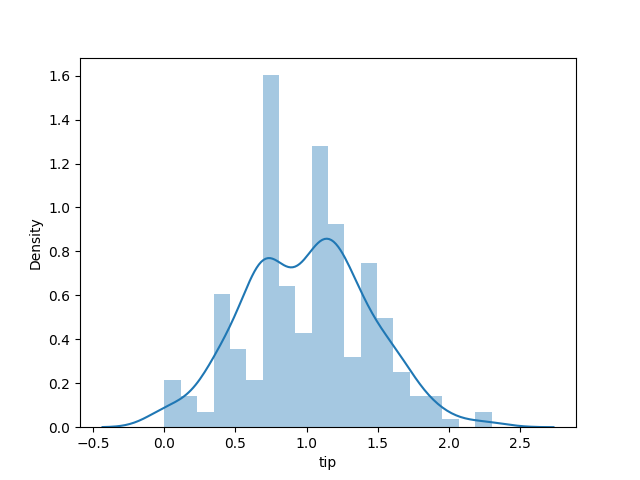
2. 关系散部图 sns.relplot:用在 x y 关系为相对(另一绝对散部图见补充 1.)
# hue= : 可以依照选择 item 以颜色区分
sns.relplot(x='total_bill', y='tip', data=tips, hue='smoker')

3. 盒需图 sns.boxplot
sns.boxplot(x='day', y='tip', data=tips, hue='sex')
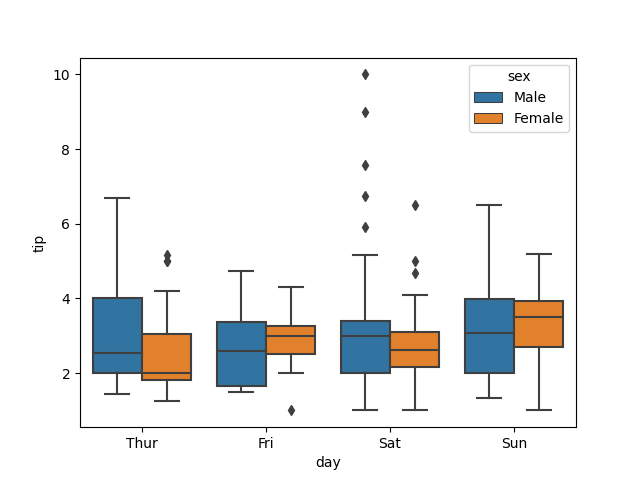
4. 小提琴图 sns.violinplot
# split=True:可将 hue 的内容分布在两侧
sns.violinplot(x='day', y='tip', data=tips, hue='sex', split=True)
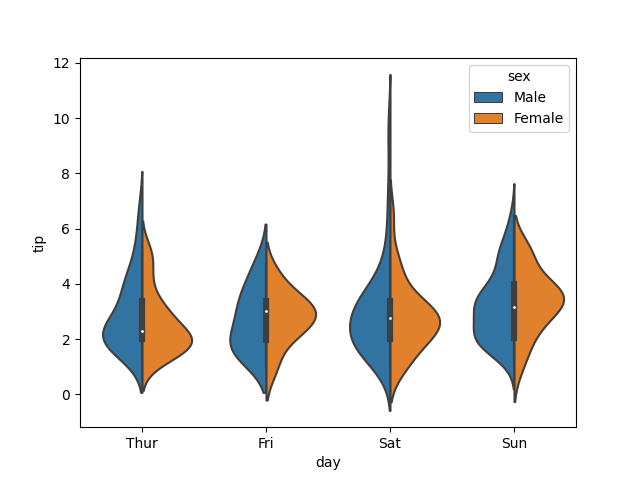
5. 点图 sns.pointplot
sns.pointplot(x='day', y='tip', data=tips, hue='sex')
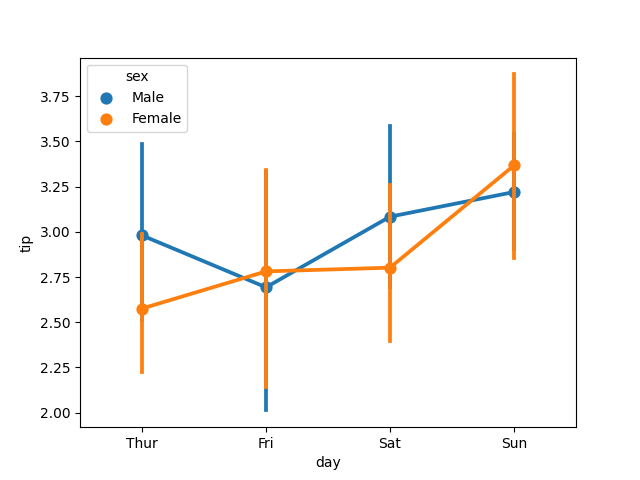
6. 配对图 sns.pairplot:把各个 item 配对成散部图
sns.pairplot(tips)
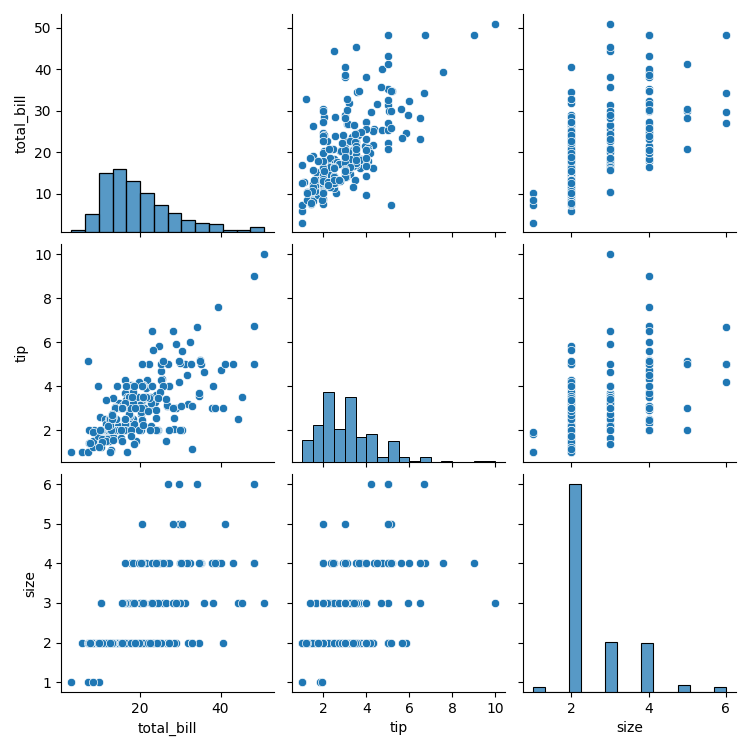
7. 热力图 sns.heatmap:把各个 item 配对,依照影响权重上色
sns.heatmap(tips.corr())
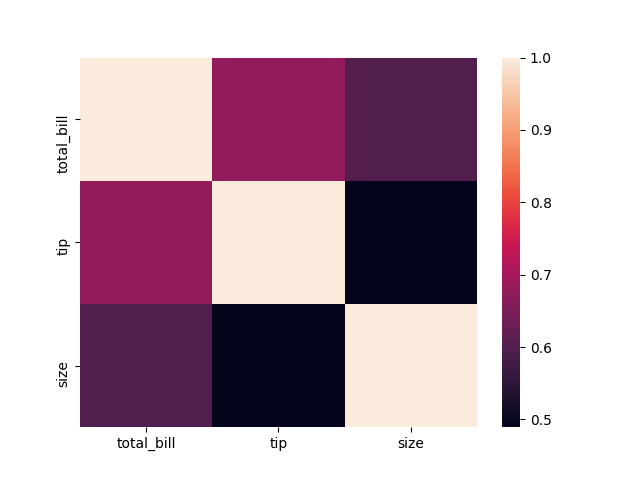
看完以上,接着用经典范例-铁达尼号 来操作 EDA:
1. Import tools & Load data
import pandas as pd
import seaborn as sns
df = sns.load_dataset('titanic')
df.head(10)

查看资料类型
df.info()
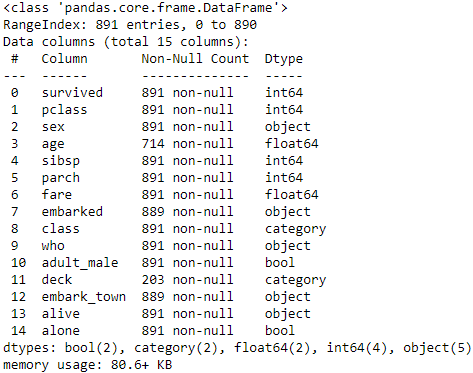
查看描述统计量
df.describe(include='all')
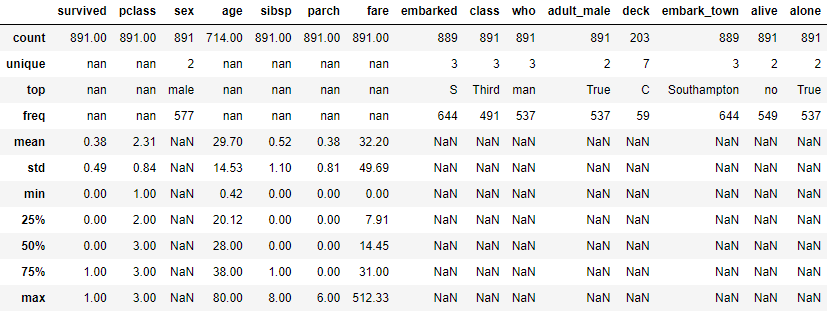
2. Analysis Y (此例中为'survived')
df['survived'].nunique()
>> 2
df['survived'].unique()
>> array([0, 1], dtype=int64)
df['survived'].value_counts()
>> 0 549
1 342
Name: survived, dtype: int64
3. Deal w/ NaN value
# initial data
df.head()

# check NaN value
df.isna().sum()
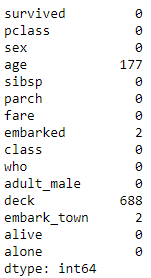
可以发现有许多重复/缺失项目,下面一项一项来处理:
A. 删去重复项目
df.drop(['who', 'deck', 'embark_town','adult_male', 'deck', 'class', 'alive', 'alone'],
axis=1, inplace=True)
df.head()

B. 填补缺失项目
B-1. 填补 age
df[df['age'].isna()]
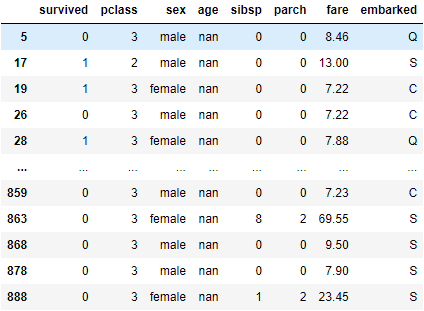
# 使用中位数来填补
df['age'].fillna(df['age'].median(), inplace=True)
df.iloc[[5, 17, 19, 26, 28]] # 挑其中几个检查
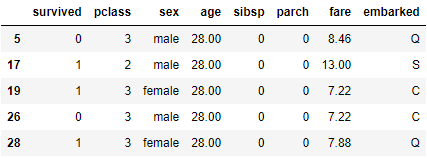
B-2. 填补 embarked
df[df['embarked'].isna()]

# 以前面一个的值填补
df['embarked'].fillna(method='ffill', inplace=True) # 或者 method='bfill'
df.iloc[[60, 61, 828, 829]]

*Double check
df.isna().sum()
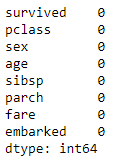
4. 转换非数字资料
有序 ordinal: 特徵值隐含顺序及大小高低之分 如: 'class' 'age' 等
名目 nominal: 不含顺序大小 如: 'sex' 'embarked'
A. 将 'sex' 转换为 0/1
df.sex.unique()
>> array(['male', 'female'], dtype=object)
df.sex = df.sex.map({'male':1, 'female':0})
df.head()
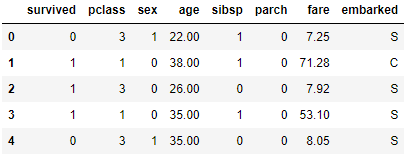
B. 将 'embarked' 转换
# 确认登船港口 vs. 生存率
sns.barplot(data=df, x='embarked', y='survived')
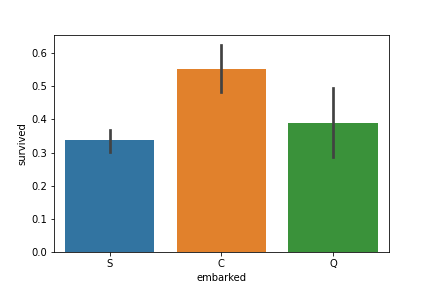
根据史料,登船港口依序为 Southampton -> Cherbourg -> Queenstown
此结果显示登船港口与生存率无显着相关,并没有因为早上船而容易死亡。
故将其转换为 one-hot encoding,避免影响判断。
df.embarked.unique()
>> array(['S', 'C', 'Q'], dtype=object)
# Transfer
df = pd.get_dummies(df, columns=['embarked'])
df.head()

C. 将年龄转换为级距
因考虑各个年龄层生存机率应相近,故使用 pd.cut() 将 'age' 切成几个级距。
首先观察各个级距存活率:
bins=[0, 12, 22, 30, 50, 60, 100]
age_cut = pd.cut(df['age'], bins)
sns.barplot(x=age_cut, y=df['survived'])
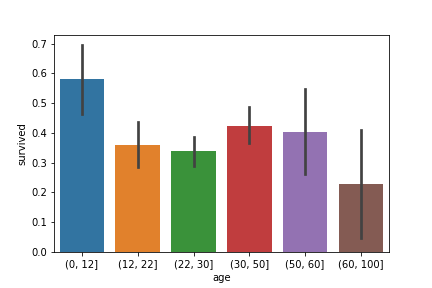
依据上图,将各个年龄层进行有序 (ordinal) 编码。生存机率最高为 5;最低为 0。
df['age'] = pd.cut(df['age'], bins, labels=[5, 2, 1, 4, 3, 0])
df.head()

D. 归一化 'fare'
找出票价为 0 者:
df[df['fare'] == 0]
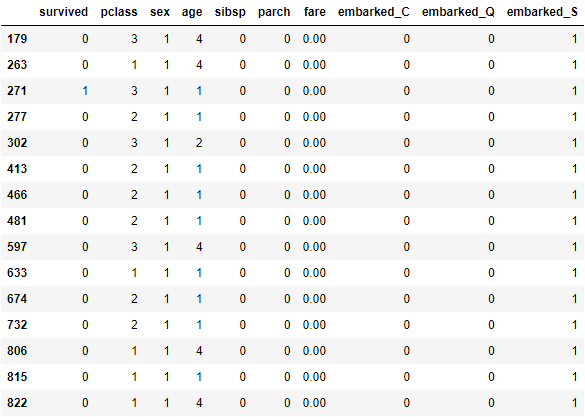
重设票价 0 为至少 1 块钱:
df[df['fare'] == 0] = 1
df.iloc[[179, 263, 271, 277, 302]]

归一化:
import numpy as np
df['fare'] = np.log(df['fare'])
df.head()

5. Analize relationship between X & Y
资料整理完成後 方可确认各个资讯间的关联,以下用热力图做范例:
sns.set(style='ticks', color_codes=True)
plt.figure(figsize=(14, 12))
sns.heatmap(df.corr(), linewidths=0.1, square=True, linecolor='w', annot=True)
plt.show()
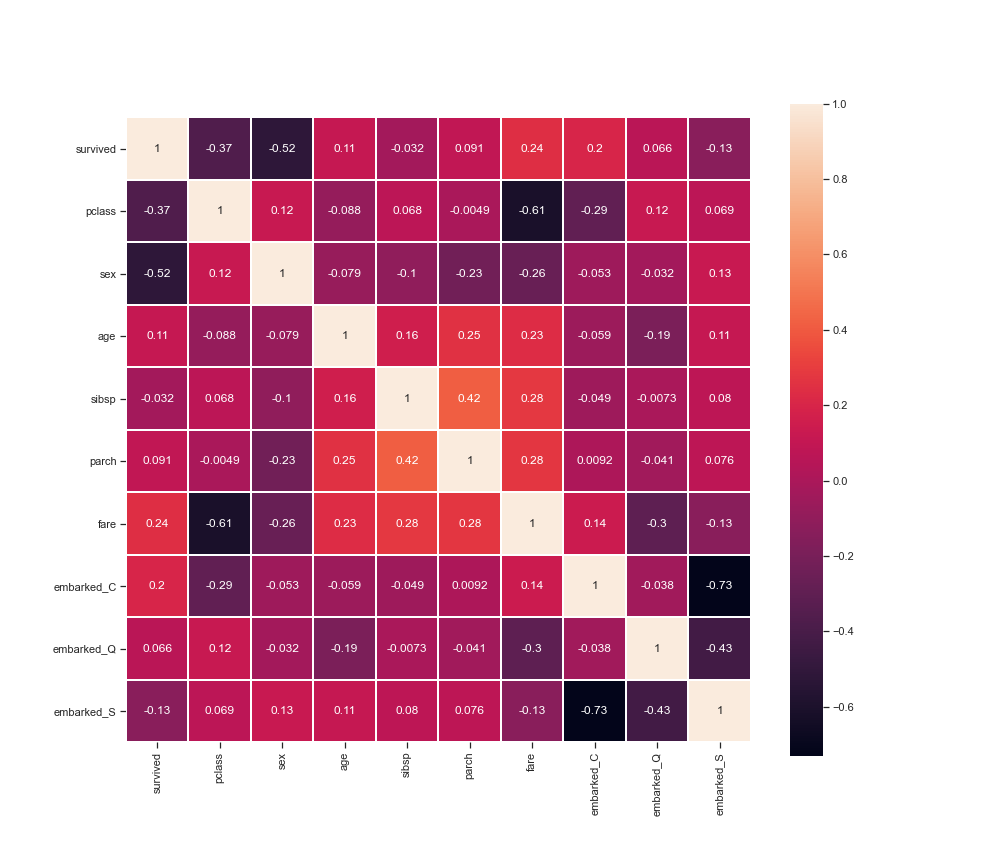
从以上分析可知:生存机率与舱等、性别高度相关。
6. Split Data
from sklearn.model_selection import train_test_split
y = df['survived']
X = df.drop('survived', axis=1)
X_train, X_test, y_train, y_test = train_test_split(X, y, test_size=0.2)
7. Feature Scaling (Normalization or Standardization)
为使收敛速度加快,通常在切割资料後会进行以下步骤其一:
- 正规化 Normalization: 将资料等比例缩放到 [0, 1] 区间中。
X_nor = (X - Min)/(Max-Min) - 标准化 Standardization: 将资料经 Z 转成标准常态分布 (Standard Normal Distribution),即 X 距离 mean 有多少 std。
X_std = (X - Mean)/(Sigma)
两种方式皆可,在此处使用标准化:
from sklearn.preprocessing import StandardScaler
stdsc = StandardScaler()
X_train_std = stdsc.fit_transform(X_train)
X_test_std = stdsc.transform(X_test)
8. Modeling (Regression)
此处我们采用 LGBMClassifier 演算法
import lightgbm as lgb
from lightgbm import LGBMClassifier
clf = lgb.LGBMClassifier(
objective = 'binary',
learning_rate = 0.05,
n_estimators = 100,
random_state=0)
clf.fit(X_train_std, y_train)
9. Score Model
clf.score(X_test_std, y_test)
>> 0.8212290502793296
10. Evaluate Model
我们可以利用一些简单的 AutoML,将所有演算法/参数跑一遍并评估可行性:
from lazypredict.Supervised import LazyRegressor, LazyClassifier
cls = LazyClassifier(ignore_warnings=False, custom_metric=None)
models, predictions = cls.fit(X_train_std, X_test_std, y_train, y_test)
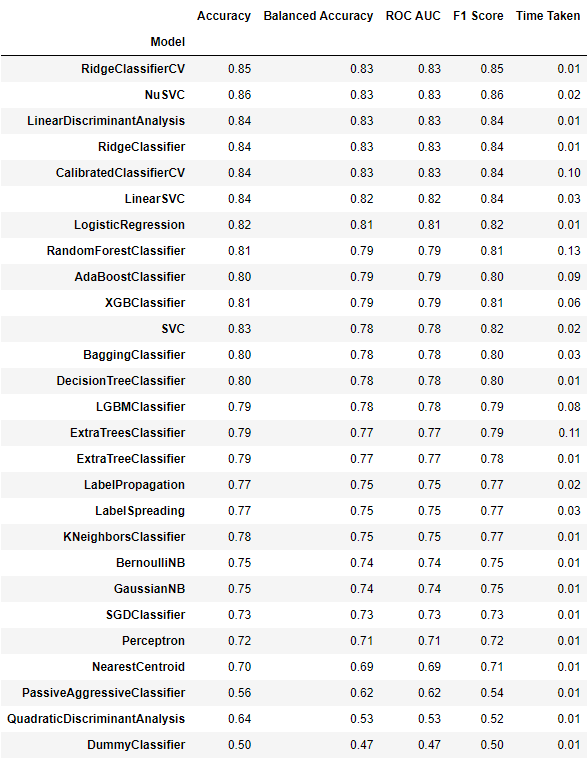
11. Save & Load Model
sklearn 有提供一内建存取方式
import joblib
model_file_name = 'model clf.joblib'
joblib.dump(clf, model_file_name)
读取方式:
clf_load = joblib.load('model clf.joblib')
接着试着输入资料来使用演算法
根据 EDA 的过程,会需要以下转换函式
import pandas as pd
import numpy as np
def convent_sex(sex):
return 1 if sex=='male' else 0
def convnet_age(age):
bins=[0, 12, 22, 30, 50, 60, 100]
return pd.cut([age], bins, labels=[5, 2, 1, 4, 3, 0])[0]
dict1 = {'C': 0, 'Q':1, 'S':2}
def convnet_embarked(embarked):
x = dict1[embarked]
if x == 0:
return 1, 0, 0
elif x == 1:
return 0, 1, 0
elif x == 2:
return 0, 0, 1
Method 1. 用 list 输入 (转成 np array/DataFram)
X = []
X.append([2, convent_sex('male'), convnet_age(31), 1, 2, np.log(32), *convnet_embarked('Q')])
X.append([1, convent_sex('female'), convnet_age(28), 1, 2, np.log(500), *convnet_embarked('Q')])
X=np.array(X)
丢进演算法中
X_test = stdsc.transform(X)
y = clf_load.predict(X_test)
y
>> array([0, 1], dtype=int64)
Method 2. 用 dict 输入 (转成 np array/DataFram)
X_1 = {
'pclass':2,
'sex': convent_sex('male'),
'age': convnet_age(31),
'sibsp': 1,
'parch': 2,
'fare': np.log(32),
'embarked_C': 1, 'embarked_Q': 0, 'embarked_S': 0
}
X_2 = {
'pclass':3,
'sex': convent_sex('female'),
'age': convnet_age(28),
'sibsp': 1,
'parch': 2,
'fare': np.log(500),
'embarked_C': 1, 'embarked_Q': 0, 'embarked_S': 0
}
df = pd.DataFrame([X_1, X_2], index=[0, 1])
df

丢进演算法中
X_test = stdsc.transform(df)
y = clf_load.predict(X_test)
y
>> array([0, 1], dtype=int64)
至此,就完成了经典题目:铁达尼号 的演算法演练了!
结论:
EDA 为在资料收集完成後的前处理,相对其他步骤来说,是最重要的步骤。
若资料处理(补偿、合并、删除)不够全面,将导致演算法 output 出一个不够全面的模型,使预测失准。
.
.
.
.
.
*补充1.:
绝对散部图 sns.catplot:用在 x y 关系为绝对
sns.catplot(x='day', y='tip', data=tips, hue='sex')
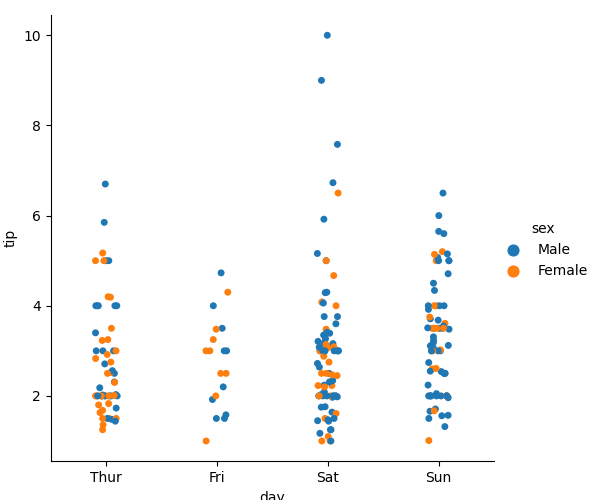
.
.
.
.
.
Homework Ans:
使用假设检定,检定近40年(10届)美国总统的身高是否有差异?
(Data: president_height.csv)
- Data Set
import pandas as pd
df = pd.read_csv('./president_heights.csv')
height = df['height(cm)']
- 建立双样本:A. 近10届 (Sample2) B. 其他总统 (Sample1)
from scipy import stats
sample1 = height.head(len(df)-10)
sample2 = height.tail(10)
- ttest 检定 (两样本独立)
z, p = stats.ttest_ind(sample1, sample2)
print(f'Z-value: {z}')
>> Z-value: -2.69562113651512
print(f'P-value: {p}')
>> P-value: 0.010226470347307223
- 作图 (直方图)
# 根据 sample1 平均值 & 样本标准差,划出抽取 100000 次分配
s1_bar = np.random.normal(sample1.mean(), sample1.std(), 100000)
plt.hist(s1_bar, bins=100)
plt.axvline(s1_bar.mean(), c='y', linestyle='--', linewidth=2)
# 计算信心水准 95%,双尾检定结果(一边 2.5%)的 x_bar 值
ci = stats.norm.interval(0.95, s1_bar.mean(), s1_bar.std())
plt.axvline(ci[0], c='r', linestyle='--', linewidth=2)
plt.axvline(ci[1], c='r', linestyle='--', linewidth=2)
# 根据 mean + t*s 划出对立假设 x_bar 落点
plt.axvline(s1_bar.mean() + z*s1_bar.std(), c='m', linestyle='--', linewidth=2)
plt.savefig('pic HW9-2')
plt.show()
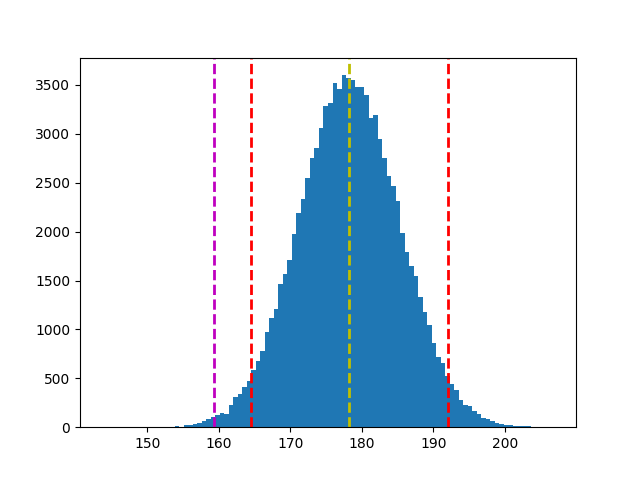
结论:近40年(10届)美国总统的身高有显着异於前任总统。
.
.
.
.
.
Homework:
请参考铁达尼号的流程,使用钻石清理资料来完成演算法。
>>: Day 18 Compose Gestures II
Multidimensional Scaling(MDS)
今天想来谈谈一个把高维度资料可视化的应用:MDS,MDS是一种unsupervised machin...
【DB】B tree B+ tree
从今天开始不讲 Leetcode 了除非有想到什麽还没点到。 後面要提一下对於其他知识点的准备, 毕...
Day 28 实作 admin_bp (1)
前言 今天要开始写 admin_bp,有蛮多部分跟之前很像。 /admin_dashboard/po...
Day 24 - WooCommerce: 建立信用卡付款订单 (下)
昨天晚上完成了建立信用卡付款订单的主要逻辑,在操作购物车,进到结帐页面後,填写完收件人资料,按下结帐...
Day34 ( 游戏设计 ) 射击外星人
射击外星人 教学原文参考:射击外星人 这篇文章会介绍,如何在 Scratch 3 里使用建立分身、移...